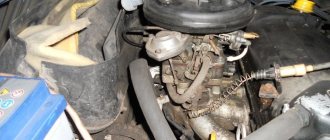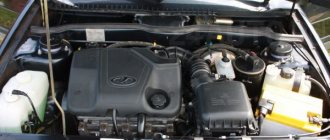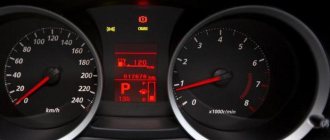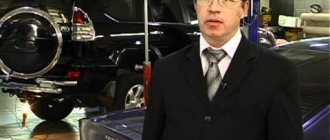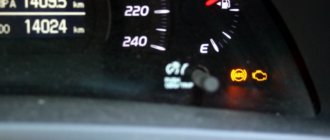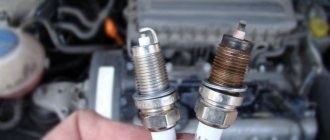If one of the cylinders completely refuses to work and the engine stalls, then during its operation you can hear the indignant grumbling of the engine. “Boo-boo-boo” means it’s time to see a specialist. Moreover, you should not postpone this visit, since the wear of the motor in this case will be much stronger than during normal operation. If the engine stalls, its compression is significantly reduced, and all the necessary conditions are present for scuffing to occur on the pistons and cylinders. In this case, the operating temperature of the engine increases significantly, and therefore it begins to overheat.
Without fully understanding all the nuances, it may seem that identifying such a malfunction is quite easy. But it also happens that the engine works absolutely normally, does not overheat and still starts to stall. In this regard, we will try to tell you point by point how to correctly diagnose and what you should first pay attention to in order to determine the cause of the engine tripping.
Spark plugs are to blame
Most likely, the cause of the engine tripping is the spark plugs. In order to verify this fact, you should unscrew the spark plug from the cylinder and carefully inspect it. If the engine is operating correctly, the color of the side electrode, as well as the insulator, will be quite light. A brown tint is also allowed. A spark plug in this condition should be fully functional. But if the carbon deposits on the candle turn out to be black, then it simply cannot be working. It is either enriched with fuel or filled with oil.
Due to carbon deposits formed on the spark plug, it may not work at all or only work occasionally. Both the first and second options interfere with the normal formation of a spark.
The reasons for the appearance of carbon deposits on candles may be:
- the car engine has been idling for a long time or has been warming up for a long time;
- there is reduced compression in the cylinder;
- valve timing is shifted or disturbed;
- the injector is not working correctly;
- The oxygen sensor is faulty.
Next, it is imperative to pay attention to the housing in which the spark plug itself is placed. It should be completely white, without black dots or stripes. If, nevertheless, stripes or dots are visible on the body, this indicates that the spark plug is breaking through normally, but will not work.
But if, after inspecting the spark plug housing, nothing of the kind was found, you should check the spark while cranking the starter. To do this, a spark is inserted into the tip of a high-voltage wire and placed on the engine ground. The engine is cranked by the starter. At this time, you need to see if a spark jumps between the two electrodes of the spark plug. If it is visible to the naked eye and has a pronounced blue color, the candle is working correctly.
Replacement, performance check
For ease of access to the DS, it is better to drive the car into a pit or overpass, since it is easier to reach it from below. The only tools you need are 21 (22) and 10 keys, as well as a flat-head screwdriver.
You need to unscrew the DS counterclockwise. Since the sensor body is plastic, it can often be unscrewed by hand, but you may need to slightly loosen the fastening with a 21 (22) key.
We screw a new DS in place of the removed one, making sure that its pin fits into the hole in the actuator rod.
There is no need to tighten it with a wrench so as not to break the plastic thread; hand force is enough.
Sometimes problems with the operation of the sensor are not related to it, but to the drive. The fact is that some models use a plastic drive rod gear, and often its teeth “lick” themselves.
Therefore, when replacing the DS, it would not be superfluous to check the condition of the drive. To do this, after removing the sensor, you need to unscrew the drive mounting nut with a 10 mm wrench and carefully remove it, prying it slightly with a screwdriver.
It is important to ensure that the shock does not jump out and get inside the box.
After making sure that everything is in order with the drive gear, we install everything in place. Then we check whether the gears are engaged.
To do this, we jack up one front wheel, turn on speed 4 and ask an assistant to turn it, while we ourselves check with our fingers whether the rod rotates.
After checking the drive, screw on the DS and connect the wiring. All that remains is to check whether the symptoms of the malfunction have disappeared.
To do this, you can start the engine and monitor the behavior of the speedometer needle and listen to whether the interruptions in the operation of the power plant at idle have disappeared.
And then we just go out onto the highway and look at the behavior of the needle and the engine while driving.
Or you can check everything by measuring the voltage at the terminals with a multimeter.
Inspection of high voltage ignition wires
If it turns out that the spark plugs are in perfect order, this most likely means that the problem lies in the high-voltage wires.
In order to test this theory, it is necessary to consider each wire separately. First of all, you should pay attention to the tip of the wire that is inserted into the spark plug. It should be completely monochromatic and not have any plaque on it. The presence of foreign scale on it indicates that for some time this high-voltage wire worked in extreme mode. If this problem is not corrected in time, the wire may subsequently break, which will lead to much more serious problems and costs.
Injector malfunction
Trouble the VAZ-2115 engine? This may be due to faulty injectors. This happens if:
- the injector is faulty (this is quite rare);
- low-quality fuel is used;
- injectors require cleaning;
- The power or control circuits to the injector are shorted or completely broken.
If one of the sensors does not work, an error will appear on the dashboard, which will serve as a kind of scanner. But if the error does not appear, then the problem lies precisely in the mechanical part.
And it also happens that it is simply not possible to find the reason why the engine is tripping. In this case, it is necessary to use computer diagnostics of the car, after which the cause of the tripping will become completely clear. As a rule, a motor malfunction of this kind can only be detected by a specialist. Therefore, it is best to contact professional service centers. This will help save both time and your own money.
Why did the engine start to stall? – The most complete analysis of the reasons
What does the term “Engine Troit” mean? I ask this question at the beginning of the article in order to cut off the “couch experts”, and only real car enthusiasts who love and appreciate their car remain here.
Just one of the commentators began to assert:
“Engine tripping is when there is no one cycle in the operation of an internal combustion engine. That is, out of four cycles of engine operation, one cycle was thrown away.”
I explained to him that he was wrong, but he didn’t get it. To prevent such armchair army specialists from wasting their time and “cracking” in the comments, I want to cut them off right away.
Why the car engine started to misfire - the most common reasons
Now let's continue the conversation with real car lovers.
Today we will look at the main reasons why the motor may trip. They may seem banal, but read my work to the end carefully, I am sure you will learn something new for yourself.
VAZ-2115 1.6 injector
Since 2007, the VAZ-2115 began to be equipped with a more powerful and modern 8-valve 4-cylinder engine VAZ-11183 with a volume of 1.6 liters. This engine had a power of 82 hp. and torque increased to 120 Nm, but the main thing is that it was even more economical and reliable than the VAZ-2111 engine.
Fuel consumption VAZ-2115 1.6 injector per 100 km. Reviews
- Ivan, Tomsk. VAZ-2115 was my first car - I bought it in 2010. Engine 1.6 injector, wet asphalt color - not a car, a dream. The engine started perfectly even in severe frost, there were no problems with it. Moreover, the consumption is moderate - on the highway 5.5-6.0 liters, in the city up to 10 liters in winter.
- Kirill, Krasnodar. The car was purchased in 2014 at a dealership with a trade-in. Who can say why a VAZ and not a used foreign car - because for 180 thousand you won’t buy an almost new car. I liked the consumption - it comes out to 5.5 liters on the highway, and not 95, but 92 gasoline, in the city from 9 to 10 liters.
- Satar, Moscow. Lada VAZ-2115, 1.6 engine, 2007. I bought the car from my father - he was switching to a Duster, and he offered me to buy his car. Well, it would be stupid not to take it - it’s in excellent condition, my father literally licked it, so he didn’t even think about it. The average consumption was 10-11 liters, but just before I was planning to sell it, the consumption began to slowly increase, and it came out to at least 12 liters.
- Pavel, Kyiv. The only reason I drive a VAZ-2115 is the low price of spare parts and low consumption on the highway. I get about 5.5 liters, and I go 120-130 km/h. It is difficult to find a Lanos with such an engine in good condition, and the Sens is not even close to the “tag”.
- Anatoly, Nalchik. You can’t really accelerate here - second or third, except that outside the city you can turn on fourth or fifth. Therefore, consumption is always higher than in any other city. But on my VAZ-2115 the consumption of more than 10-11 liters in the city never rose, and outside the city it was 6-7 liters, no more.
- Vladimir, Moscow. VAZ-2115 (Samara-2), 1.6 liter injection engine with 81 hp, 2011. A normal car even for Moscow - no worse than all sorts of Solaris and Aveos, and in terms of price and fuel consumption it is much more profitable. My consumption in Moscow in traffic jams reached a maximum of 15 liters - my friend’s Toyota is consistently 20-22 liters. And if you travel outside the Moscow Ring Road, then 5.5 liters, no more. The only negative is that it’s scary to drive more than 130 km/h, it’s very light.
- Andrey, Kirov. I bought my VAZ-2115 three years ago at a dealership. Four months later the rear struts began to leak, and six months later the transmission and pump failed. And this is in a new car! What is this called? The only thing that was normal about it was its consumption - it was not small, but at the level of its classmates, from 6 liters on the highway to 11 liters in the city.
- Alexander, Yaroslavl. A normal car for the money. If you look after her, she won’t create any problems. And if a person constantly puts the pedal to the floor, then he does not do it as needed, but when there is money, it is natural that the car will go down quickly. In terms of consumption - although the engine is eight-valve, it consumes a little. In the city, 9.5 liters in summer and 11 in winter (this is the maximum), highway from 5 liters (90 km/h) to 9 liters (130-140 km/h).
- Evgeniy, Krivoy Rog. The only thing I don't like about the "tag" is that it is light. If you go on the highway at a speed of 130 km/h, then it starts to throw, it’s downright scary. If there are a couple of people in the car and there is some kind of cargo in the trunk, then of course you drive more confidently, but the consumption also rises to 8.5 liters.
Many motorists, especially beginners who have just purchased a VAZ-2114, have wondered how the 8-valve injection engine that is installed on this car works. This article will discuss the design of the motor, its main characteristics, as well as dismantling and repair features. This information will be very useful for beginners and those who do not know how the main power unit works.
Video about the VAZ-2114 engine
Video review of the VAZ-2114 engine operation, features and characteristics.
Reason one - spark plugs
I wrote in detail about how to determine faults in car systems using spark plugs here .
I recommend reading it - it turned out to be useful, judging by your reviews, thank you.
We unscrew the spark plugs one at a time and look at their insulator. If it is covered with dense carbon deposits, then it is difficult for a spark to penetrate it. The current seeks the path with the least resistance, so the spark will not be between the electrodes, but will “go” along the insulator to the side. Its energy will not be enough to set fire to the air-fuel mixture. This cylinder will not work.
Heavy carbon deposits on the spark plug electrodes may cause the engine to trip.
We inspect the external condition of the spark plug insulator. If there are microcracks, then part of the current will not be converted into a discharge, but will escape through these damages. You need to look at the internal insulator, which is screwed into the cylinder head, and at the external one, onto which the armor wire cap is placed.
Any chips or damage can lead to poor sparking or its complete absence.
A superficial breakdown of the spark plug insulator is one of the reasons why the engine began to fail.
A large or small gap between the electrodes. Many people have heard or know that for certain engines, ignition systems and types of fuel used, spark plugs with a certain gap are required. Usually its value is indicated by the manufacturer of engines and cars.
In order for the spark plug to work well and the engine not to stall, a certain gap between its electrodes is needed
How to check the spark without special devices on the engine
This is an old, “grandfather” method, some people are afraid of it:
- They unscrewed the spark plug;
- They put an armored wire on her;
- They leaned it with the inner body, the metal part, against the engine;
- Turn on the ignition and turn the starter.
Be sure to hold on to the rubber cap of the armored wire, otherwise your hand will shake violently. This is what many are afraid of
